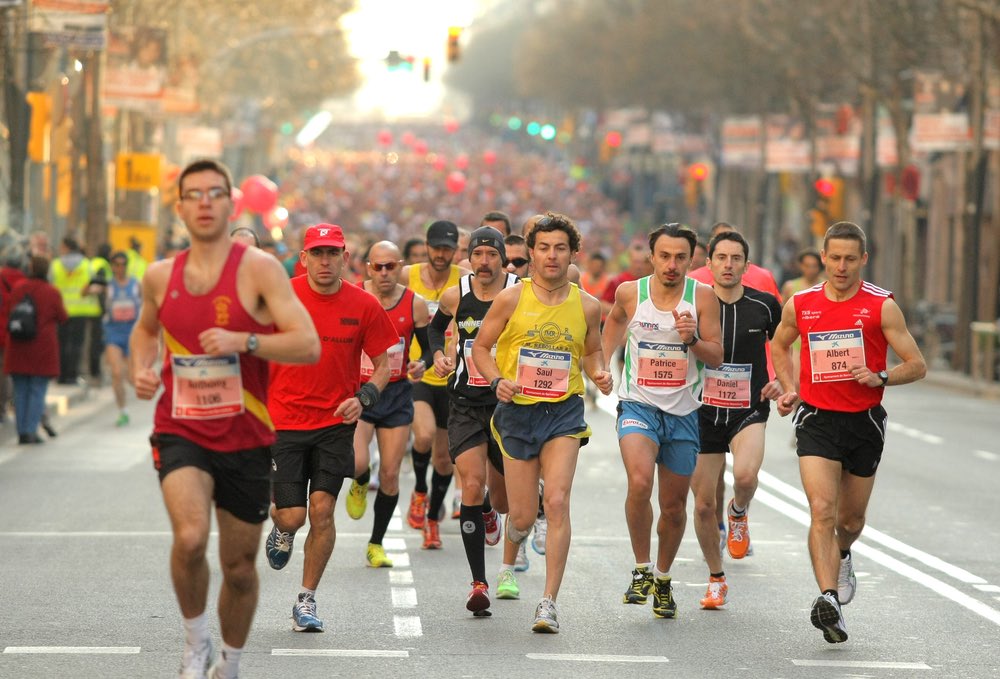RUNNING
Half marathon training to crack 2 hours with our expert training guide

The cooler months in Australia — from April to September — herald the half marathon season. If you’ve always wanted to have a crack at the popular 21.1km event — or have run one but would like to get fitter and do even better — the MF guide will help you get there.
Our 12-week program has been put together by one of Australia’s top coaches, Sean Williams (sweatsydney.com.au). Although Sean has written training programs for elite runners in his squad such as Ben St Lawrence, masters athlete Keith Bateman and rising stars Harry Summers and Lara Tamsett, his MF plan for a sub-two-hour half marathon contains the same principles with regards to how often, how far and how fast to run each session.
The program requires four training sessions a week and is designed to help you nail a sub-two-hour time. For those of you planning to run faster than that, you can still use Sean’s plan, but adjust the pace and intensity to suit you and your goals for the event.

Click here for your 12 week training guide
HOW TO DO THE KEY TRAINING SESSIONS
Tuesday run:
- This consists of 10 minutes of easy paced jogging to warm up, taking it very easy (approximately 7min-per-km pace). You then roll straight into the “threshold pace” run. This is right at the upper end of your aerobic limits, where you can still converse with someone while running, but only in short sentences. Threshold running will help you become used to running at half-marathon pace, which, for a two-hour half marathon, is five minutes and 41 seconds per kilometre. You can measure this either using a GPS watch or on a measured course such as a 400-metre running track. Running on a 400m track at 5:41 per km, you would reach each 400m in 2:16. End the session with 10 minutes of easy paced jogging as a warm-down, taking it easy (approximately 7min-per-km pace).
Thursday hills or track:
Do 10 minutes of easy paced jogging to warm up.
- Track session: Hit the targets for the 200m, 400m and 800m repetitions at the prescribed pace on the program. Make sure your jog recovery between reps is very slow (about 8mins-per-km pace). Do 10 minutes of easy paced jogging (approximately 7min-per-km pace) to warm down.
- Hill session: For a 60-metre hill session, you have to run up the hill and back down in 1 minute. Aim to run strongly up the hill in approximately 25 seconds and jog down in approximately 35 seconds. That’s called a “1-minute cycle”. Do 10 minutes of easy paced jogging (approximately 7min-per-km pace) to warm down. These track and hill sessions will help you tolerate race pace, as they will help improve your VO2 max (the maximum capacity of your body to transport and use oxygen during exercise) and lactate threshold.

The Saturday and Sunday run:
l These should always be at an easier pace than race pace (approximately 6:30 per km is fine — a bit faster if you’re feeling really comfortable) and could be done on road and/or trails or parklands. They’re very important to build your endurance for the half marathon.
TIPS FOR A GREAT RACE
Good advice for a hot half marathon.
- Train at the same time of day as the race will be run. This will help set your body’s schedule for eating and toilet breaks.
- Familiarise yourself with the course as a mental rehearsal. This could mean running over part of it ahead of race day or checking over the course map and finding a similar route to train on.
- You don’t need to cover the full 21.1km before race day — that’s what the race is about. However, to build stamina, you do have to ensure that your last long run is in the 17-19km range.
- Taper properly. “Cutting back on training 7-9 days before your half will allow you to be rested and race at your best,” says Sean. “The gains from tapering — fresher legs and a hungry mind — are substantial. You’ll be faster.”
- Make sure everything you’ll wear on race day fits properly — socks, cap, shoes etc. If you’ve bought yourself new runners to race in, test them out over at least a total of 30km of training before you wear them for the race.
- Leave the iPod at home. Although mobile music can be an asset on long solo runs, most race organisers frown on their use or ban them altogether.
- If you’re not that concerned about your time for the race, go out at an easy “talking pace” for the first 14km. If you’re feeling fine at that point, up the pace as desired.
- Check the weather forecast. If it’s going to be cold on race morning, don’t waste energy shivering in your singlet at the start — wear an old unwanted sweatshirt you can ditch, or fashion a big black garbage bag into a makeshift poncho that’ll keep your warmer.
- Don’t stress — being agitated on race day will waste much-needed energy. Work out driving directions and any pre-race preparations needed. Breakfast, change of clothes, shoes, bib number — have it all figured out before you hit the sack. You’ll sleep and run better.

HOW TO CARBO-LOAD
If you think carbohydrate loading equals stuffing pasta and bread down your throat for a week before the half marathon, you might actually be hindering your results. Sabrina Rogers-Anderson helps you get it right.
What is carbo- loading?
This tried and true technique involves changing your training and nutrition in the lead-up to an endurance event to maximise your muscle glycogen (carbohydrate) stores, which can increase your endurance and result in a 2 to 3 percent improvement in performance.
How does it work?
The original seven-day carbo-loading method was developed in the ’60s by Swedish physiologist Gunvar Ahlborg. The initial depletion phase involved a stint of hard training followed by three to four days of very low carbohydrate intake (10 percent of total kilojoules). This was followed by a loading phase of solid rest and very high carbohydrate intake (90 percent of total kilojoules). The first phase was believed to improve the absorption of carbohydrates in the secondary phase.
Modern methods
Research has since shown the depletion phase isn’t necessary. Modern carbo-loading involves a week of tapering (low exercise load) and a high-carb diet (70 percent of total kilojoules) for three days prior to the race.
The most recent — and arguably the best — carbo-loading method was developed by researchers at the University of Western Australia in 2002. Athletes maintain their normal diet and train lightly until 24 hours before the event. On the day before the race, they perform a short but very high-intensity workout, then consume 12g of carbohydrates per kilogram of lean body mass for 24 hours. The result is a 90 percent increase in muscle-glycogen storage.
Loading mistakes
Sports dietitian Sally Garrard warns against carbo-loading mistakes.
- 1. “To get a carbo load, you need to taper. Take rest days before your race.”
- 2. “Carbo-loading isn’t an excuse to gorge, unless you want to feel sluggish. Also, avoid excess fats, like creamy pastas.”
- 3. “If your gut is sensitive, you may need to reduce your fibre intake during carbo loading. Choose Rice Bubbles over Vita Brits, and eat less veggies and salad.”
- 4. “Finally, never try eating anything new on race day.”
RUN TO THE BEAT
Music is a legal stimulant. An inspirational tool. A welcome distraction from aching muscles and blistering feet. And while some music may not boost your half marathon performance (jog on, Celine Dion), the right choices can have you raving across the finish line. By Tim Spicer
Sports psychologist Peter Terry, from the University of Southern Queensland, has been studying how music can assist an athlete’s performance. He surveyed 11 elite triathletes running on a treadmill, either listening to motivational music, or with nothing, — and those with music ran for 75-78 seconds longer. But why?
“Music reduces your perceived exertion,” says Terry. “It works like a metronome, regulating movement for greater economy. It also provides a generalised relaxation response, which enhances blood flow,” he says. “It also distracts from fatigue, and provides a rhythm to concentrate on, which makes it easier.”
Music has proven benefits for running, but how do you structure the most efficient playlist for your half?
“You need to know your stride rate,” says Terry. “Then choose music with a tempo that matches it exactly.”
In 1998, Ethiopian distance runner Haile Gebrselassie [twice Olympic champion and eight-time world champion], broke the 2000-metre world indoor record after asking for “Scatman” by Scatman John to be played, so he could match his stride to its 135 beats-per-minute.
Professor Terry’s research has been used by Mizone to create four songs that assist exercise performance. Download them for free at mizonemusic.com.au.




